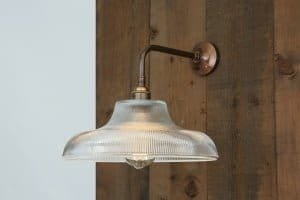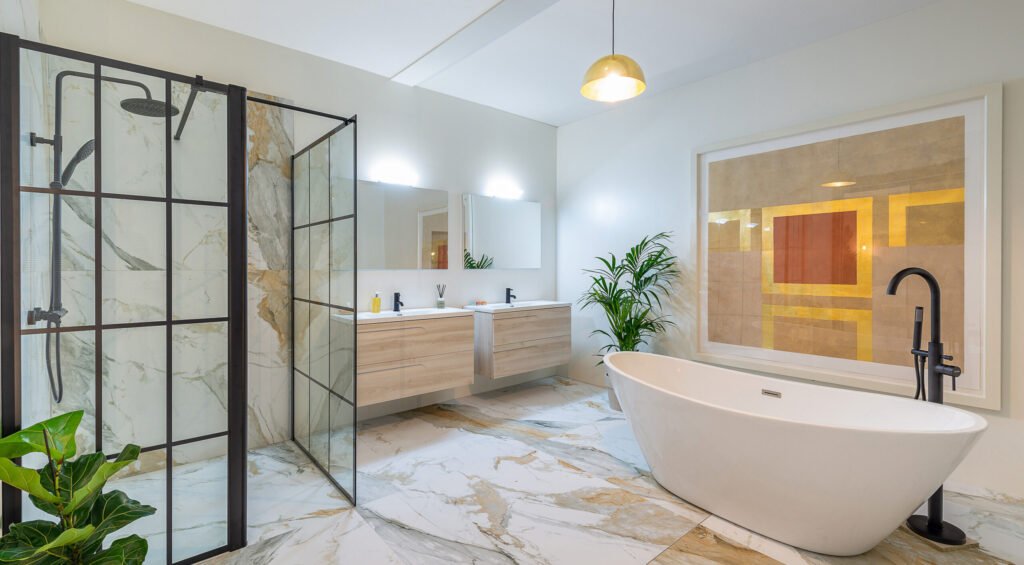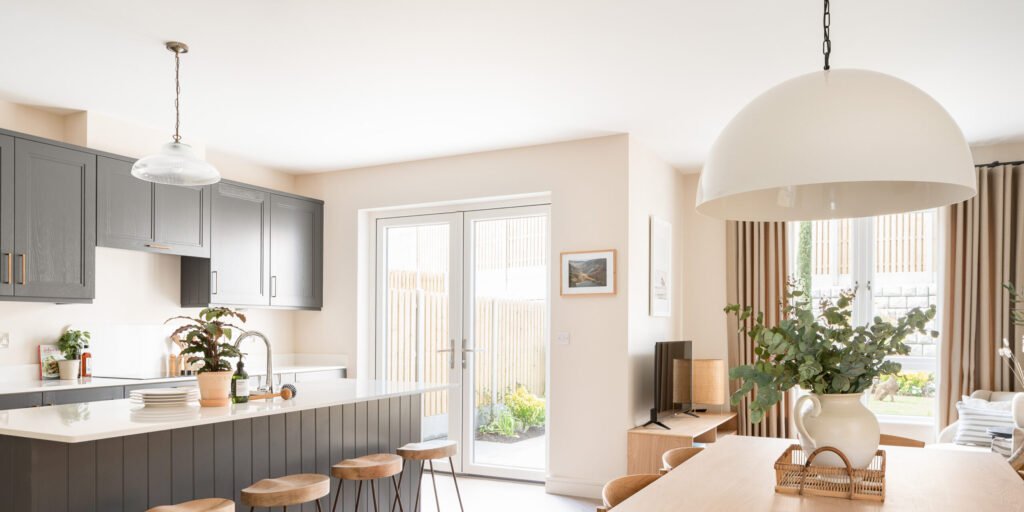Your Complete Guide to Bathroom Lighting
Bathroom Lighting That Actually Works
Your bathroom does double duty every single day. It’s where you rush through your morning routine at 7am, and where you unwind in a hot bath at 9pm. Getting the lighting right transforms it from purely functional to genuinely enjoyable—but get it wrong, and you’re stuck applying makeup in shadows or showering in a spotlight.
Let’s make sure you get it right the first time.
The Three Layers Every Bathroom Needs
Forget about installing one ceiling light and calling it done. Proper bathroom lighting uses three distinct layers working together:
Ambient Lighting: Your Foundation
This is your overall room illumination—the lighting that lets you safely navigate at 3am without tripping over the bathmat. Recessed downlights or flush ceiling fixtures work brilliantly here. The secret? Make them dimmable. Bright light for morning showers, soft light for evening baths. It’s that simple.
Task Lighting: Where It Really Matters
This is lighting with a job to do—illuminating your face clearly for shaving, makeup application, or skincare routines. The golden rule? Position lights on either side of your mirror at face height, not above it. Side-mounted sconces eliminate those unflattering shadows that make you look tired even when you’re not.
If side mounting isn’t possible, an LED strip above the mirror works, but it’s second-best. The goal is even, shadow-free light on your face.
Accent Lighting: The Luxury Touch
This is your mood-setter. Under-cabinet lighting, illuminated shelving, or even a small chandelier adds warmth and character. It’s the difference between a bathroom that feels clinical and one that feels like a spa. Not essential, but absolutely worth considering if you’re creating a space you’ll love spending time in.
Bathroom Zones Explained (Without the Jargon)
Safety regulations divide bathrooms into zones based on water exposure. Understanding these isn’t just about ticking boxes—it’s about choosing lights that’ll last and keep you safe. If you want the full bathroom lighting regulations follow the link
Zone 0 – Inside the Bath or Shower Requires fully waterproof, low-voltage lights (12V maximum). Honestly? Unless you’re installing underwater mood lighting, most people don’t put fixtures here at all.
Zone 1 – Above the Bath/Shower Extends up to 2.25 metres above your bath or shower tray. Needs IP65-rated lights minimum—these handle direct water jets from your shower head. Downlights designed specifically for showers fit here perfectly.
Zone 2 – Around the Bath/Shower Extends 60cm beyond Zone 1 and around washbasins. Requires IP44 minimum, which handles splashes and steam. Most bathroom wall lights fall into this category.
Outside Zones – The Rest of Your Bathroom Technically, standard IP20 lights work here, but we’d always recommend IP44 minimum for bathrooms. Steam travels, and moisture-resistant lights simply last longer in bathroom conditions.
Quick Decision Guide:
- Shower ceiling lights: IP65
- Lights near sinks and mirrors: IP44
- General bathroom ceiling lights: IP44 (even if technically outside zones)
- Well away from water: IP44 still recommended for longevity
Sizing Your Lighting Right
Small Bathrooms (Under 5 Square Metres)
Less is more. A single flush ceiling light plus one or two wall sconces by the mirror often suffices. The trick? Choose fixtures that punch above their weight—well-designed lights can illuminate effectively without overwhelming a compact space.
Medium Bathrooms (5-10 Square Metres)
You’ve got room to layer properly. Consider:
- 2-3 recessed downlights for ambient lighting
- Wall sconces flanking the mirror
- Optional: accent lighting in alcoves or under cabinets
Large Bathrooms (10+ Square Metres)
Go to town with proper layering:
- Multiple downlights creating even coverage
- Dedicated vanity lighting
- Statement pendant or chandelier (if ceiling height allows)
- Accent lighting highlighting features like a freestanding bath
- Separate lighting zones for different areas
Ceiling Height Matters Too:
High ceilings (2.7m+)? Pendant lights or small chandeliers add drama without being impractical.
Standard ceilings (2.4m)? Stick with flush or semi-flush fixtures that don’t overwhelm the space.
Matching Your Style (Not Fighting It)
Your bathroom lighting should feel like it belongs, not like an afterthought. Here’s how to nail it:
Modern Bathrooms
Choose sleek, minimalist fixtures with clean lines. Chrome or brushed nickel finishes work beautifully. Integrated LED mirrors, recessed downlights, and geometric wall sconces complement modern tiles and fittings perfectly.
Traditional Bathrooms
Ornate wall sconces, vintage-style Edison bulbs, and fixtures with brass or bronze finishes create period charm. Look for IP-rated versions of classic designs—you don’t have to compromise on safety for style.
Nautical Themes
Industrial-style pendants, weathered brass finishes, and fixtures with maritime details bring coastal vibes indoors. Just ensure your “vintage” look still carries proper IP ratings for bathroom use.
Contemporary-Traditional Mix
This is where most real homes live. Blend classic shapes with modern finishes—think traditional sconce shapes in contemporary brushed brass, or Edwardian-inspired fixtures with integrated LED technology.
Wall Lights vs Ceiling Lights: The Winning Combination
Wall Lights Excel At:
- Task lighting around mirrors (eliminate those shadows!)
- Adding style and character
- Creating softer, more flattering light
- Illuminating specific zones
Ceiling Lights Excel At:
- Overall room brightness
- Even distribution of light
- Illuminating darker corners
- Providing practical visibility
The Truth? You need both. Ceiling lights alone cast shadows where you need clarity most—your face in the mirror. Wall lights alone don’t illuminate the whole room effectively. Together, they create flexible, functional lighting that actually works for everything you do in your bathroom.
Bulbs That Make Sense
LED is Your Best Friend
Modern LED bulbs offer everything you need:
- 80-90% less energy than old incandescent bulbs
- 15-25 year lifespan (yes, really)
- Available in any colour temperature you want
- Dimmable options widely available
- Zero warmup time—instant full brightness
Colour Temperature Matters
This is where people often go wrong. Bathroom lighting needs careful consideration:
- 2700K (Warm White): Cosy and relaxing, but can make colours look slightly yellow. Great for evening ambiance.
- 3000K (Soft White): The sweet spot for most bathrooms—warm enough to be flattering, clear enough for tasks.
- 4000K (Natural White): Crisp and clear, excellent for makeup application, but can feel clinical if used everywhere.
- 5000K+ (Cool White): Too harsh for bathrooms—makes everyone look washed out.
Our recommendation: Stick with 3000K for general bathroom lighting. It’s flattering without compromising on clarity.
Quick Wins: Accessories That Complete the Look
Once your lighting’s sorted, these finishing touches make a real difference:
Illuminated Mirrors
Combine your mirror and task lighting in one sleek package. LED-framed mirrors provide excellent, even facial illumination whilst looking thoroughly modern.
Heated Mirror Pads
Not lighting per se, but they stop your mirror fogging up, which means your carefully planned lighting actually works after showers.
Coordinated Finishes
Match your light fixtures to your taps and accessories. It’s a small detail that creates a cohesive, well-thought-out space.
Dimmer Switches
Cannot stress this enough—dimmable lighting transforms your bathroom’s versatility. Bright for getting ready, soft for unwinding.
Five Mistakes Costing You Money
1. One Ceiling Light and Nothing Else
This creates shadows exactly where you need clear visibility—your face in the mirror. Always add wall-mounted task lighting.
2. Lights Positioned Above the Mirror Only
This casts shadows downward, making bags under your eyes look worse and making daily grooming tasks harder. Side-mounted sconces are infinitely better.
3. Choosing Style Over IP Rating
That gorgeous vintage sconce might look perfect, but if it’s not rated for bathroom use, it’ll corrode, fail, or worse—become a safety hazard. Always check the IP rating first.
4. Ignoring Colour Temperature
Cool white LEDs (5000K+) make everyone look ghastly in bathroom mirrors. Stick with 3000K for flattering, functional light.
5. Making Nothing Dimmable
Fixed-brightness lighting means you’re stuck with the same intensity whether it’s 7am Monday morning or 10pm Friday night. Dimmer switches cost little but add enormous flexibility.
Your Action Plan: Getting It Right
Step 1: Identify your bathroom zones and note what IP ratings you need for each area.
Step 2: Plan your layers—one ambient source (ceiling), task lighting (mirror area), optional accent lighting.
Step 3: Choose fixtures that match your style whilst meeting IP requirements.
Step 4: Select 3000K LED bulbs throughout for consistent, flattering light.
Step 5: Install dimmer switches on at least your main ceiling lights.
Need Help Choosing?
Every bathroom is different, and generic advice only gets you so far. Our team has helped hundreds of homeowners create perfectly lit bathrooms—we know what works in real homes, not just design magazines.
Browse our complete range of bathroom lighting or get in touch for specific recommendations based on your space. We’ll help you choose lighting that’s safe, stylish, and actually works for how you use your bathroom.
For detailed information about bathroom zones and regulations, check out our bathroom lighting zones guide.
All our bathroom fixtures are manufactured to exacting UK and EU standards, with proper IP ratings clearly marked. No guesswork, no compromises—just lighting that works brilliantly for years to come.
.jpg)
Bathroom Pendant Lights



